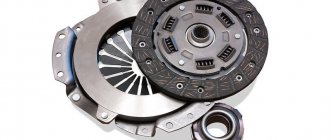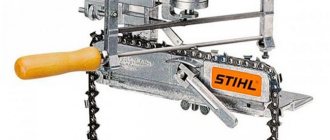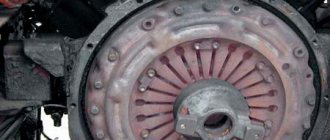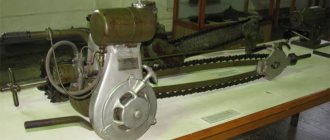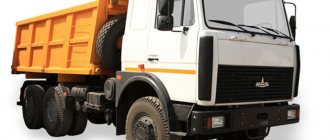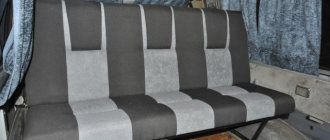Domestic SUV
Russia is famous for its off-road conditions, which is why jeeps and other all-terrain vehicles are so popular here. However, not everyone has the financial opportunity to purchase expensive imported jeeps, especially since sometimes SUVs absolutely cannot cope with off-road conditions in certain regions of the country. Domestic technology comes to the rescue, which over many years has proven its quality and appropriateness in certain conditions. Thus, the UAZ 469 SUVs and their later modifications are rightfully considered the best, overcoming sometimes unimaginable swamps with a rut depth of up to a meter. The only drawback is the UAZ 3303 clutch, which often fails.
The principle of operation of the clutch on the UAZ loaf
By pressing the pedal, the driver acts on the fluid in the line. The fluid transfers pressure from the master cylinder piston to the slave cylinder piston. The master cylinder moves the fork piston.
The release fork presses against the release bearing, which transmits force to the clutch mechanism, which disengages the transmission from the transmission.
By releasing the pedal, the driver returns the entire mechanism to its original state. Under the action of the return spring, all elements involved in the process of disengaging the clutch assume their normal positions, this is how the UAZ loaf clutch works
Operation of the GVC
Below is a brief description of how the clutch works:
- When you press the clutch pedal, the pusher moves the piston and the compensation hole closes.
- It pushes fluid in front of it into the system, creating pressure.
- This pressure acts on the piston of the working cylinder, which pushes the rocker arm through the rod.
- The fork, moving the release bearing, acts on the crankcase petals, releasing the pressure plate from the clutch disc.
The valve and disc play an important role in the pumping process. Even if the system is not primed, it will still fill up. Simply unscrew the master cylinder valve and allow the fluid to flow through it. It fills the system by gravity, the same applies to the brakes.
The liquid enters through the expansion port into the cavity in front of the piston through the valve into the line. When filling is complete, the liquid flows out through the valve. The most important thing is that the piston rod should not be extended, and the expansion hole should not be blocked by the handle.
When pumping, everything happens a little differently.
- When the piston moves forward, valve 19 is open.
- When moving backwards, the valve is closed and the front valve creates a vacuum.
- There are holes in the piston that are closed by plate 3. It retracts and opens the holes. Liquid flows from the space above the piston and reservoir through the bypass hole into the space in front of the piston, which is under pressure. The collar (cork) allows it to overflow.
- When the lock ring is reached, the piston stops and the spring compresses the plunger and plate. It's ready for a new cycle.
Clutch design of the most common UAZ models
The entire clutch system UAZ loaf
First, let's define the term "clutch". It is necessary for smooth connection and disconnection of the crankshaft with the vehicle transmission. This is necessary when changing the driving mode (changing gears in the transmission) or stopping the car. The UAZ 469 military jeep was equipped with a dry single-plate clutch, a very popular system in the automotive world at that time. This coupling consisted of the following components:
- pressure disk in the housing;
- special pressure springs and clutch release levers;
- friction disc equipped with friction linings.
The general design looks like this. The so-called casing (clutch housing with all mechanisms) is bolted to the crankshaft. Alignment is established according to the factory marks on the housings. It is important to understand that when the driven and driven plates touch, a tremendous amount of friction is created to transfer torque from the crankshaft to the vehicle's transmission, which transfers it to the wheels.
The pressure plate is installed together with springs, protected from overheating by special insulating washers on the side of the pressure plate. For this reason, the basket is made of alloy and leaves ventilation holes, and the pressure plate is installed together with springs, which are protected from overheating by special heat-insulating gaskets on the side of the pressure plate.
Let's look at the clutch control mechanism itself. It consists of:
- unlocking levers that are installed on the pressure plate;
- release clutch with thrust roller bearing;
- Clutch selector fork mounted on the crankcase.
UAZ owners know that it is difficult to get to the clutch without removing the engine; you need an overpass or an inspection channel.
It is clear that in order to begin repairing a particular unit, you need to understand where the fault is, and only diagnostics can provide such understanding.
Return to contents
The positive aspects of SUVs
SUVs such as UAZ 469, UAZ 3303, UAZ 3909 and other cars of the Ulyanovsk Automobile Plant have shown their high cross-country ability, which for many citizens of our country is a top priority, especially during spring thaw or deep snow in winter in rural areas.
Thanks to all-wheel drive and high ground clearance, a harmonious combination of engine power and transmission, it was possible to create unpretentious all-terrain vehicles that work well in harsh winters and hot summers.
Excellent maneuverability
It should be noted that these cars were tested by designers in different field conditions for years. And the fact that SUVs made in the USSR were in great demand in the world leaves no one in doubt. They were supplied to all continents; 100 foreign countries appreciated the quality of Soviet technology.
Clutch malfunction UAZ loaf
The main malfunction of the GTZ is damaged flanges. If the “mushroom” is faulty, the piston will not create pressure in the system, and the UAZ loaf clutch will stop compressing. It usually has nicks, cracks, or is simply worn out. Frequent, repeated clicks will, of course, help, but not for long. You can't rush and get stuck. You need to replace the cuff or replace the main cuff entirely.
In the second option, if the second ring is damaged, the liquid will leak out. DOT will drip onto the cabin floor. It is quite possible to replace the ring from the repair kit.
Frequent malfunctions and their causes
The clutch system of a UAZ car is characterized by various violations: the reinforced clutch of the UAZ is a loaf, the mechanism does not squeeze out, slips or does not pump. Timely maintenance, replacement of worn parts, lubrication and monitoring of the fluid level in the tank, diagnostics of all systems and mechanism components allows you to avoid such problems.
Clutch repair UAZ loaf
Having a diagram of the internal structure allows you to carry out repairs yourself in case of simple defects. Increased fuel and oil consumption, coolant leakage, unusual noises and knocking in the mechanism are the first signs of the need for repairs. Maintenance and replacement of worn parts help extend the life of parts and vehicles.
How to adjust the clutch pads
To adjust the UAZ loaf clutch, the following repair work must be performed:
- Using a ruler, measure the free radius of movement of the drive pedal that disables the mechanism. The standard value for the spring type should be in the range from 35 to 55 mm, for the membrane type - from 5 to 30 mm.
- Measuring the full travel of the pedal when it is lowered all the way. The standard value for the lever-spring type is 18.5 cm, for the membrane type - 16.5 cm.
- Set the desired position by changing it using the key.
- Check the distance with the pedal down between the engine block bulkhead and the center of the rod shaft. The value of 9.6 cm must be achieved. The fork free play must be at least 1.7 cm. Changing the length of the work basket bias rod is an adjustment tool. To do this, remove and reinsert the pusher until the desired value is reached.
Adjustment of the clutch pedal free play is required if the distance between the rotating part located on the tension arms and the adjusting screws and fasteners is not within the range of 50.75-52.25 mm. The bolts can be unscrewed and tightened until the desired size is achieved.
The diaphragm spring assembly does not require free adjustment and does not require adjustment of the mechanism locking system. The correct clearance and stroke dimensions are ensured by design features.
Clutch master cylinder repair kit
The assembly quality of the UAZ clutch cylinders leaves much to be desired. Some drivers switched to VAZ cylinders, which are more reliable. I also stopped using repair kits because they were just as problematic. With cheap repairs, the service life of the repaired main battery ranged from one month to six months.
To replace the gaskets:
- unscrew the main connector;
- Squeeze the flange and piston towards the piston end;
- Make sure the mirror is not scratched;
- Remove the retaining ring;
- Wipe all parts and the inside of the cylinder with a clean cloth;
Replacing the clutch of a UAZ loaf with your own hands
First, drain any remaining fluid in the system. This can be done using a syringe. This operation is necessary in order to flush the hydraulic cylinder system from contaminants. On some models, access may be limited by the cooling system expansion tank. For convenience, loosen the nuts holding the tank and remove the hose. It should be unscrewed with a 10 mm wrench. Next, remove the metal tube coming from the clutch master cylinder. It could be copper or aluminum. Then remove the master cylinder by unscrewing the two mounting nuts with a 13mm wrench. You must use a 17mm socket to remove the hose coming out of the slave cylinder. Then we will need a 13mm wrench again.
Use it to unscrew the two bolts securing the clutch cylinder. The UAZ is in neutral gear at this time. The working cylinder itself in this car is installed on the gearbox housing. Carefully remove the pushrod from the fork to avoid damaging other components. If the hoses are removed “on the fly”. (i.e. with the component removed), the cylinder can be secured on one side with an adjustable wrench, and the tube can be unscrewed on the other side using a spanner. However, be careful, as the rubber may break under mechanical stress.
Need for adjustment
Adjusting the pitch of the cone in the clutch cylinder is done to ensure that the clutch performs its task correctly. If configured incorrectly, two types of interference may occur.
Free play adjustment
This is the distance the pedal can be moved without encountering resistance and without causing the clutch to engage or disengage. The free wheel is adjusted after replacing the mechanism or when the discs are worn. The clutch release drive consists of a working drive and a release bearing fork. The release mechanism housing is located on the bell body and is secured with two bolts. The pusher and rocker arm are located inside the housing.
The free wheel is adjusted by changing the length of the rod with the cylinder removed.
To adjust, follow these steps:
- Dismantle the clutch cylinder and remove the pusher;
- Loosen the lock nut and unscrew (tighten) the piston rod no more than 5 mm;
- Reinstall the pusher and assemble the control center.
Since the adjustment unit is not visible from the outside, if the adjustment is incorrect, the slave cylinder must be disassembled again.
Source
Design
Unlike front-wheel drive foreign cars, on all-wheel drive UAZ Patriot vehicles the clutch slave cylinder (its adjustment is at the end of the article) is hydraulic and is controlled using fluid pressure, and not a cable. The design of this element includes several components. This:
- Frame. It is made of plastic or metal.
- Piston (working rod).
- A valve that releases air when the clutch system is bleeding (adjusting).
- Retaining ring.
- O-rings. Made from durable rubber.
- Return spring.
- Pusher. It affects the previous element.
Frequent malfunctions and their causes
The clutch system of a UAZ vehicle is characterized by various malfunctions: the clutch is strengthened, the mechanism does not disengage, slips or does not pump. Timely maintenance, replacement of worn parts, lubrication and monitoring of the liquid level in the tank, diagnostics of all systems and components of the mechanism help to avoid such problems.
The operating instructions provide basic information about the operation of transport units, their preparation for operation, the rules and frequency of monitoring the functionality of the units, the main malfunctions and the decoding of error codes. Following the manufacturer's recommendations will extend the life of the equipment. Simple breakdowns can be fixed yourself.
For more complex system malfunctions, it is recommended to contact a service center.
The first category of reasons relates to the problem when the system cannot start completely when the pedal is lowered. The algorithm of actions is as follows:
- Lack of free play on the pedal. Repair measures consist of adjusting the shutdown drive.
- A malfunction in the pressure plate movement design requires replacement of the part or removal of the cause of the jam.
- Defective pressure springs, reduced force. Purchasing new spare parts will help correct the situation.
- Oil getting on the friction surface of the discs. It is necessary to rinse and wipe the elements dry with gasoline.
- Prolonged slippage causes overheating. The mechanism will cool down on its own after some time.
If the system starts up jerkily or with vibration, the reasons may be as follows:
- Oil getting on the friction surface of the discs. It is necessary to install a new part or wipe the old one with gasoline, remove protruding irregularities on the surface of the pressure plate and flywheel.
- Friction linings worn down to the rivets indicate the need for immediate replacement of the component.
- Incorrect placement of the pull levers. It will be necessary to dismantle the clutch and adjust the components.
If an extraneous noise occurs when you press the pedal, this may indicate that the bearing has become unusable or lacks lubrication. If using oil does not help, you will need to purchase a new element. A break in the release spring makes it impossible to lock the pedal in the upper position. The spring needs to be replaced.
Clutch disappears
Often the mechanism does not start or disappears after the vehicle has been idle for a long time. The probable cause is “sticking” of the driven disk to other structural elements. If several attempts to start the car do not lead to success, it is better to contact a service center. In this case, you will not be able to correct the situation on your own.
Drives the clutch
A common group of malfunctions is associated with a situation where the clutch is driven and there is no way to completely disengage the mechanism. There could be several reasons:
- Free play is greater than the permissible limit. An adjustment needs to be made.
- Damage to the driven disk. It is necessary to change or, if possible, correct the deformation.
- Destruction of driven disk elements. There is only one way out - to purchase a new part.
- Air entering the hydraulic piping system. Pumping the mechanism will help correct the situation.
- Hub jamming. Remove nicks, foreign elements, burrs and other causes of structural malfunction.
- Incorrect placement of the pull levers. It will be necessary to dismantle the clutch and adjust the components.
Increased clearances in the drive also indicate the need to replace worn components.
Disadvantages and criticism of cars from the Ulyanovsk plant
Real photo inside the car
Initially, very high fuel consumption, as well as low passive safety: an accident involving a UAZ usually ends tragically. At the time of development, these shortcomings were compensated by the affordable price of gasoline and low traffic volume, which reduced the likelihood of an accident or accident to a minimum, but over time the situation changed, and today the old designs have become morally and technically very outdated, not corresponding to new realities.
Older models from earlier releases have a gearbox without synchronizers, an unreliable braking system and problems with the clutch. High fuel consumption in modern times forces owners to either buy newer models equipped with economical injectors or turbodiesels, or convert existing old cars.
Most owners, especially those with low incomes, do not try to re-equip their car; they have one pressing problem - the clutch.
With standard equipment and market quality components, replacement occurs after 5-7 thousand km when driving on normal roads. And when a UAZ is equipped with self-locking differentials or gearboxes, especially off-road, the clutch simply cannot stand it.
Repair
The presence of a diagram of the internal structure of the structure allows you to carry out independent repairs in case of simple malfunctions. Increased fuel and oil consumption, coolant leakage, uncharacteristic noises and knocking in the mechanism are the first indications for repair. Maintenance and replacement of worn-out components helps prolong the functioning of parts and vehicles.
How to adjust the clutch pads
In order to adjust the clutch on a UAZ, you will need to carry out the following repair work:
- Measuring with a ruler the free radius of movement of the drive pedal that turns off the mechanism. The standard value for the spring-lever type should be within the range of 35 to 55 mm, for the diaphragm type - from 5 to 30 mm.
- Measuring the full travel of the pedal after it has been lowered to the limit. The standard value must be found in the operating instructions for your model:
- for cars with a spring-lever type clutch system (Ulyanovsk SUVs of the 3151 family: 31512, 31514 and 31519) it is 18.5 cm;
- for the diaphragm type - on average 16.5 cm. So, for example, for UAZ Hunter it should be set in the range of 13-17 cm, for UAZ 3303 and UAZ 390945 - in the range from 18 to 22 cm.
Adjust the required position by changing the position using the key.
- Controlling the distance when the pedal is lowered between the partition of the motor part and the middle of the rod axis. It is necessary to achieve a value of 9.6 cm. The fork must have a free path of movement of at least 1.7 cm. Changing the length of the work basket pusher is an adjustment tool. To do this, you need to remove and screw back the pusher until the desired value is obtained.
Adjustment of the free play of the clutch pedal is required if the distance between the rotating part located on the release levers and the adjusting screws and elements of the device does not lie within the range of 50.75-52.25 mm. The screws can be removed and put back in until the correct size is established.
Measure the distance from the plate to the heads of each claw screw; it should not differ from each other by more than 0.2 millimeters. Tighten the adjusting screws to set the distance with the required difference. Fixation of each claw screw occurs by pushing the edges of the claws into the grooves of the screw shanks.
The diaphragm spring connection does not require free play adjustment and does not require adjustment of the mechanism release system. The correct dimensions of the gaps and strokes are ensured by the design features.
Clutch adjustment on the UAZ “Bukhanka”
“Loaf” is what the common people call van-type UAZs of the 452 model series, which were produced from 1965 to 1979; as well as UAZ 2206/3741/3909/39094/3962/3303.
Let's consider one of the most popular cars of the Ulyanovsk brand today - UAZ 3303. It has versions 330394 and 330364, differing in that they are equipped with a more powerful injection engine ZMZ-409 with 112 hp; whereas the basic configuration of the flatbed truck is equipped with a ZMZ-417 4-cylinder gasoline engine with a power of 76 hp. and volume 2.445 liters.
The internal combustion engine of this “loaf” is equipped with a dry single-plate clutch, with a central diaphragm-type pressure spring with retractable tabs. For proper operation of the engine, you need to know how to engage the clutch on a UAZ 3303.
- First you need to remove the clutch pressure plate.
- Now you need to place a ring template 9.5 millimeters between the plate and the disk, secure it to the casing with 6 bolts.
- Adjust the distance from the plate to the bolt heads. It should be 51.5 (±0.75) mm, the difference between the heads of all bolts is no more than 0.2 mm.
- Lock the leg bolts.
For clarity, we suggest that you familiarize yourself with the video of the Kolupaiev channel:
It is also worth noting that UAZ vehicles with a ZMZ-409 engine are equipped with a clutch pedal contact sensor, which is adjusted so that the gap between the buffer and the sensor rod is 0.5 millimeters.
A little about the history of the creation of the Soviet SUV
Initially, the UAZ 469 was developed as an all-terrain military vehicle, which was intended to replace the older GAZ -69 model. The car was developed from the mid-60s, and began to be mass-produced in 1972; its further modification was the UAZ-3151 (produced since 1985). The civilian modernized version was the UAZ-315195 Hunter. Three years ago, the Russian Ministry of Defense completely refused to supply UAZ, switching to other types of SUVs. Although UAZs have proven themselves in the army as reliable, unpretentious vehicles, they are very outdated.
The familiar Loaf model
The UAZ 3303 commercial truck became a further modification of the famous “loaf”, a family of cars from the Ulyanovsk plant, including the very first UAZ 450. It began to be mass-produced back in 1958. The car became the first independent development of the plant, based on the components and assemblies of the GAZ-69 and GAZ-21. The very first tests exceeded all the designers' wildest plans; the car confidently overcame even snow cover 50 cm deep, and also drove along a tank track with a load of a ton of weight. The development of the SUV began in the mid-50s, prototypes appeared a month later.
Since the GAZ 69 had an unsuccessful wheelbase, the new car had to use a carriage layout, which was developed in two modifications:
- a truck with a wooden body;
- all-metal van.
To ensure the necessary rigidity of the body, ribs were developed on the roof of the van, which visually resembled a loaf of bread. In the mid-late 80s, the “loaf” underwent modernization, the engine remained old, but boosted to 90 horses. The SUVs were equipped with an improved dual-circuit braking system and a vacuum clutch release amplifier, and the bridges were also modernized. The names have changed once again.
There appeared the UAZ-3303 - a light-duty flatbed truck, the UAZ-3741 - a multi-purpose van, the UAZ-2206 - a minibus, and the UAZ-3962 - an ambulance. Ten years later, the plant began experiments to improve the characteristics and improve the “loaf”; a variety of cars were produced, in particular, the “Farmer” family, but in the early 2000s the management changed, all new projects were canceled, and since then they have been producing one modification - van.
Clutch adjustment UAZ 469
The old-style UAZ 469 is equipped with a spring-lever clutch mechanism. Setting the gap of the release levers is similar to setting the clutch of a UAZ 3303.
In order for the clutch system to work correctly, it is also necessary to ensure the required gap of 2.5-3.5 millimeters between the heads of the bolts of the tabs and the clutch release bearing. The full travel value for this SUV is set in the range from 14 to 16 millimeters.
How to bleed the clutch
Bleeding the hydraulic drive will be required if the pedal is pressed too softly and it is not possible to completely turn off the mechanism. All this indicates the presence of air in the hydraulic drive unit. Repair measures are carried out through the bypass valve in the same way as work with a hydraulic brake drive. Having an assistant will make the task easier. Sequencing:
- Adding working fluid to the master cylinder tank to the standard limit.
- Release the bypass valve head from the protective element, connect the rubber hose.
- Preparing a container with a volume of more than 0.5 liters filled with the working mixture. Place the free end of the hose into the liquid.
- Creating pressure in the resulting system with several presses on the pedal in 1-2 seconds.
- Turn the bypass valve half a turn.
Air will escape from the system into the container with liquid. When the movement of bubbles stops, you need to press the pedal and turn the valve all the way. During activities, the presence of the mixture in the master cylinder tank should be constantly monitored to avoid re-entry of air into the system.
The described procedures are performed several times until the bubbles completely disappear.
After pumping, add liquid to the tank and return the protective cap to the valve. Do not use liquid from the container into which the hose was placed for this purpose. It contains air that disappears on its own after 24 hours or after filtration.
How to install the clutch disc correctly
The functionality of the vehicle, smooth movement, absence of noise and vibration, and comfortable movement along the highway depend on the correct installation of the part. Sequence of actions on how to correctly install the clutch disc:
- Removing the gearbox and hydraulic drive working cylinder.
- Removing the 4 bolts connecting the clutch housing at the bottom using a wrench.
- Removing the clutch housing lower element and gasket from the structure.
- Setting the position mark of the flywheel and basket - drive disk.
- Removing the fasteners connecting the basket and the flywheel.
- Removing the drive and driven disks.
One of the clutch disc surfaces protrudes more than the other. This side should be facing the gearbox. Installation of elements is carried out in reverse order. To adjust the disks, you will need a special mandrel. After completing the work, it is better to apply lubricant to the splined end of the main shaft.
